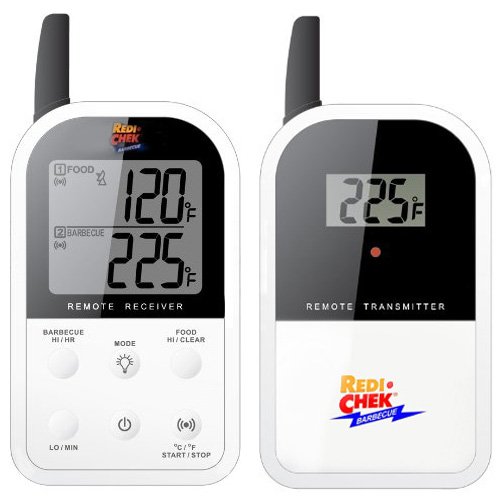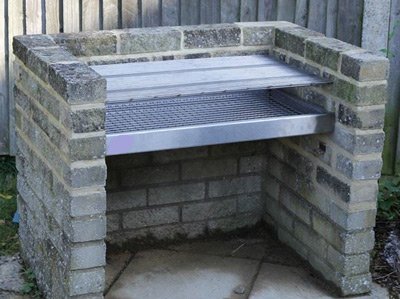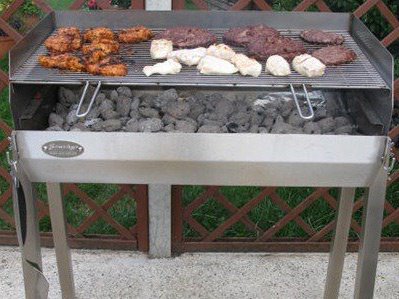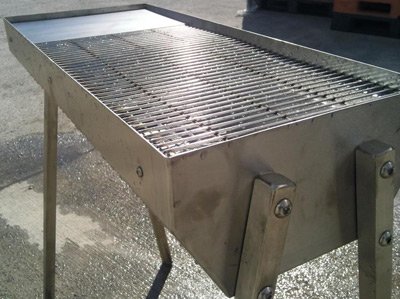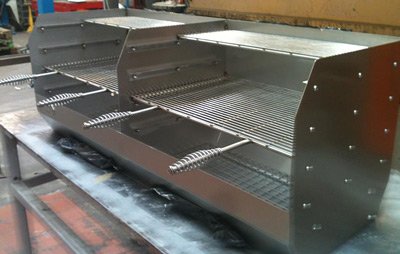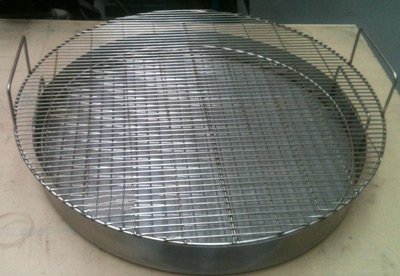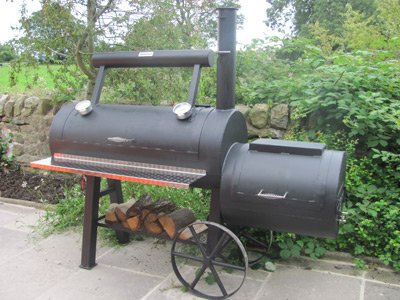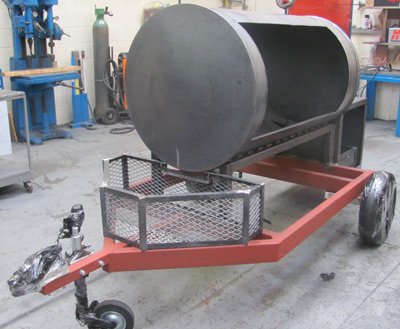A BBQ Thermometer & Temperature Probe Is Essential For Every Outdoor Chef
Using a BBQ thermometer or temperature probe is the easiest way to check that your meat has been cooked to your liking and it's also essential to establish safe internal meat temperatures so that you don't poison yourself or your guests.
Let's also be clear, the most extreme form of food poisoning ends in death. This is not an exaggeration, this is a serious matter.
Why Barbecue Cooking Needs Special Attention
Most of us are aware that:
- Good sanitation prevents the spread of disease
- Refrigeration slows down the proliferation of bacteria and spoilage
- Cooking meat kills bacteria
- Eating raw (undercooked) pork or chicken is dangerous
As barbecue enthusiasts we need to take extra care (physically) because of the types of food we cook:
- Pork
- Ground Meat (sasuage and burgers)
- Chicken
And also thermally because of how we cook it:
- Over charcoal (without exacting thermal control)
- Low and slow which exposes our meat to longer periods of time in the thermal range (between 8°C - 63°C or 46°F - 145°F) when bacteria proliferate.
Note: Whilst what I've written above might seem a little scary, with good hygiene, safe food handling and proper cooking, barbecue, smoking & grilling does not give rise to any more risk than other forms of cooking.
Bugs And Killing Them
You can kill different bugs in meat and fish in different ways such as freezing, curing (with the use of nitrites) and cooking. For more on nitrites see my section on curing meats, this part of my site is dedicated to killing bugs by cooking and so covers the following:
The Best Instant Read Temperature Probe
The Best Remote BBQ Thermometers
Safe Internal Meat Temperatures
The Bugs
Trichnosis
Trichnosis is a parasitic disease most often associated with eating under-cooked pork but it must also be noted that trichinae larvae my be present in any warm blooded omnivorous animal such as bears.
Symptoms include intestinal upset and chronic muscular pain.
There is no danger if pork is cooked to a minimum internal temperature of 58.4°C (137°F) throughout. To be even safer, use my safe temps chart.
Fish Parasites
Freshwater fish can contain parasites that are harmful to humans. The same is true of salt water fish to a lesser extent and this includes farmed fish.
There are two ways to kill the parasites:
- Cook to a minimum temperature of 60°C (140°F)
- Freeze fish at below -23°C (-10°F)
Most domestic freezers will not run at such low temperatures so if cold smoking salmon then it's best to use commercially frozen fish.
Tularemia
This is a disease of rodents and therefore relevant to rabbit and hare. Most human infection is caused by handling the raw meat so the best prevention is to use rubber gloves whilst butchering.
Symptoms include fever, chills, headaches and vomiting. Tularemia is not fatal and can be treated with anti-biotics.
After rabbit is cooked as per pork (see our chart) then it is safe to eat.
Salmonella
Salmonella is the most common cause of food poisoning and thankfully is rarely fatal. Foodstuffs most commonly associated with salmonella include poultry and eggs.
Symptoms include intestinal cramps and diarrhoea and anti-biotics provide a most effective cure.
Salmonella proliferates at temperatures between 4.5°C - 60°C (40°F - 140°F) making human body temperature a most hospitable breeding ground.
If the safe cooking temperatures below are followed and food is kept hot then the risk of salmonella poisoning is small. More likely causes include cross contamination of raw and cooked meats.
Botulism
Botulism can be fatal and therefore must be taken seriously by the smoker enthusiast. The word botulism is derived from the Latin word botulus which means "sausage". Need I say more?
A properly cooked sausage is not a problem, most cases of botulism occur through improperly processed meat. Nitrites are the chemicals to use to prevent botulism in processed meats and for more on this subject read my section on curing meats.
E. coli
I put this one in a similar category to salmonella in terms of how to avoid it but infection is certainly more serious because it can result in death.
Proper cooking (to the safe temps chart) is the best prevention and ensure good hygiene practices to avoid cross contamination of raw and cooked meats.
How To Prevent Food Poisoning
Having mentioned good hygiene practices, a lot of us are still exposing ourselves to unnecessary risk by not using a BBQ thermometer.
I used to be the sort of guy who would work on the old adage "prick the chicken and if the juices run clear then it's safe to eat... a bbq thermometer is the sign of someone who doesn't know what they are doing."
Well I've changed my mind, a bbq thermometer is the single piece of kit that every outdoor chef must have and the two common myths below give good reason why:-
Myth #1 - "If my red meat is brown inside it is cooked"
Not true. For sure red meat does turn brown when cooked but that's not the only reason meat turns brown, it also turns brown when aged. Freshly killed flesh is red because the blood (haemoglobin) is oxygenated but as meat is aged, the level of oxygen decreases and the blood turns a blue / brown so changing the colour of the meat.
Cutting into meat and checking the colour is not a reliable way of determining whether meat is safe to eat. You can't argue with the readout of a calibrated BBQ thermometer.
Myth #2 - "Chicken is done when the juices run clear"
No longer true. We consume so much chicken these days, it is intensively reared and it saddens me to say that in many cases these birds are fattened up before their bone structures are properly formed. Some of these chickens never walk in their short life-time.
For the same reason, when cooking, blood can seep out of the poorly formed bones and taint the meat. Your chicken could be perfectly cooked despite there still being traces of blood so if you're not using a BBQ thermometer you could be completely over-cooking your bird.
Use a free range bird however and your chicken should have well calcified bones.
What Type Of BBQ Thermometer Do You Need?
When considering what type of probe to buy there are essentially three steps in the good, better, best styles of BBQ thermometer.
First thing to point out is that for measuring meat temperature an instant read thermometer is absolutely essential and a digital one at that. Thankfully the old days of mechanical thermometers or mercury thermometers has been surpassed, you can still get them, they're cheap but really not sufficiently versatile for barbecuing.
Note:- This mechanical style of thermometer is the sort that will be installed in the hood of your smoker to monitor the temperature inside your food chamber. They are reasonably accurate but the negative is that they reflect the temperature where the thermometer is positioned* and not the temperature at the surface of the cooking grate and this could vary by +/- 20°C (35°F).
*The only exception that I've found to this is the JensenGrill which has its thermometer calibrated to take account of the distance between the cooking grate and the position of the thermometer.
Having concluded that a digital readout is the way to go you can next break the designs of BBQ thermometer down into two types:-
- "Instant Read" that have the display at the end of the probe and will give you a reading when you insert the probe into the meat.
- Remote thermometers have a separate read out unit connected to the probe either by wire or wireless. These
Best Instant Read Temperature Probes
The probes are best suited when you need an immediate reading and have easy access to your food:
- When you lift the lid to turn food on the grill
- When removing food from the cooking grate to rest
- When checking food left on the warming rack
The best instant read BBQ thermometer is the Thermapen
- The readout is almost instantaneous (within a couple of seconds). This is important if you're lifting the lid on your grill so you don't lose all the heat.
- The readout is large, clear and on the latest ones is also directional so that both right handed and left handed chefs can use it with ease.
- They are reliable and easy to store in your pocket or apron
I wouldn't be without my Thermapen, if I had to choose just one piece of barbecue equipment (after my barbecue) then this would be it.
I don't just use it for barbecue either, it pretty much goes wherever I go to cook.
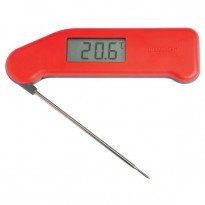 Thermapen instant read BBQ thermometer
Thermapen instant read BBQ thermometerThere are cheaper thermometers on the market, I've tried them and frankly they don't come up to the mark. This picture compares the (blue) Thermapen to a cheaper (yellow) Hygiplas probe and frankly the difference is like chalk and cheese.
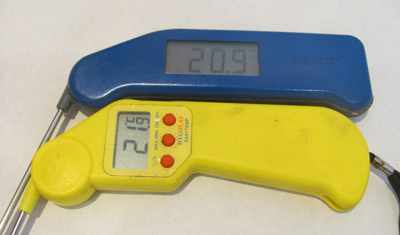 Blue Thermapen & Yellow Hygiplas
Blue Thermapen & Yellow HygiplasLook at the picture carefully and you will note that the digital readouts are not the same. Upon calibration I proved that the Thermapen is the more accurate reading.
The display readout on the Hygiplas is in the wrong aspect. Any right handed person has to tilt their head to the left to read the output and to a left handed person the readout will be upside down.
Even the basic Thermapen without the directional readout is easy for a left handed chef to read.
Moreover, take a closer look at the tip of the probe:
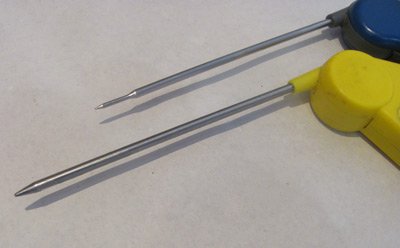 The blue Thermapen has a finer point to the probe
The blue Thermapen has a finer point to the probeThe blue Thermapen has a much finer tip allowing it to penetrate skins (such as on fish) and delicate flesh so much easier. When I tried using the yellow Hygiplas I couldn't readily penetrate the fish skin and just squished the skin down onto the flesh.
For food safety this is priority No1 and the Thermapen is the best on the market.
Note: When you've used your probe to check the temperature always use a probe wipe. Probe your meat and it is under-cooked, then next time you probe it is cooked, if you haven't sanitised your probe with a probe wipe between tests then you may have cross contaminated your cooked meat with any bugs that may have still been present in the earlier under-cooked test.
Best Remote Barbecue Thermometers
When it comes to smoking you need to be able to monitor the temperature of your meat remotely because you don't want to be opening the hood on your smoker every 30 minutes and losing all the heat in the food chamber.
This is where the remote BBQ thermometer adds value.
Your remote thermometer contains two probes or temperature sensors:
- The 1st probe is inserted into the meat remains in the meat during the cookout.
- The 2nd sensor is placed on the cooking grate to give an accurate reading of the cooking temperature at the point where the meat is actually sitting and not halfway up the lid where most built-in BBQ thermometers reside.
The display read out is provided by a separate unit which will be connected by a wire or (in the top of the range models) wireless.
These BBQ thermometers allow you to continuously monitor the meat temperature and some also have an alarm that will sound when your meat reaches the desired temperature so that you don't overdo it.
Whether you need to have a wireless thermometer is down to the design of your smoker ie. how the smoker hood closes with wires coming out or simply how much you want the state of the art.
The wireless remote unit will allow you to be up to 100 feet or so away from the your smoker so when preparing your cookout you’re not necessarily tied to standing by the barbecue smoker say if the weather's bad or like me, you smoke all year round.
I've tested a number of remote BBQ thermometers and the one that consistently comes out on top is the Maverick ET732. It's a robust accurate device and is great value for money.
If I have one niggle it's that the instructions are poor but who reads instructions these days? Five minutes playing around with it and you'll get to grips with it.
The final option is to have a BBQ thermometer with more than one probe, this will allow you to check more than one point in the meat without having to move the probe manually (something that would again require opening the smoker hood). This can be a particular advantage when cooking a large bird like a turkey because you can insert one probe in the breast and one in the thigh and keep a check one both temperatures at the same time.
For an extra $10, choose the Maverick ET-733
Calibrating Your Temperature Probe
It pays to calibrate your temperature probe on a regular basis to check that it is giving an accurate readout and there's a very easy way to do this:
- Insert the probe into water on a rolling boil...it should read 100°C or 212°F
- Insert it into iced water and it should read 0°C or 32°F
As a double check, if you have more than on probe, test them simultaneously. If they both read the same then the chances are they are accurate no matter at what temperature you choose to test.
Safe Internal Meat Temperatures
You can check that your food is cooked and safe to eat when you achieve the following internal meat temperatures:-
| Fahrenheit | Celsius | |
|---|---|---|
| Beef | ||
| Rare | ||
| Medium Rare | ||
| Medium | ||
| Well Done | ||
| Veal | ||
| Medium Rare | ||
| Medium | ||
| Well Done | ||
| Lamb | ||
| Medium Rare | ||
| Medium | ||
| Well Done | ||
| Pork | ||
| Medium | ||
| Well Done | ||
| Ham | ||
| From Raw | ||
| Reheating Cooked | ||
| Poultry | ||
| Whole Chicken | ||
| Whole Turkey | ||
| Roast Breast | ||
| Wings and Thighs | ||
| Stuffing | ||
| Duck & Goose | ||
| Ground Meat | ||
| Turkey & Chicken | ||
| Beef, Veal, Lamb & Pork | ||
| Eggs | ||
| Fish | ||
Seafood is a little less definitive, I don't use a BBQ thermometer for these, it's best just described in the following way:-
Finfish - Cook until opaque and it flakes easily with a fork OR if the skin comes away easily from a fillet, it's cooked.
Shrimp, Lobster & Crab - Shells turn red and the flesh is white opaque
Scallops - Turn milky white and become slightly more firm
Clams & Mussels - Cook until the shells open, discard any that don't open
Avoid Food Poisoning With My 4 Food Hygiene Recommendations
For those that do want to know it all, the signs and symptoms of food poisoning range from tummy ache, diarrhoea, vomiting, abdominal cramps, and in more severe cases, fever, dehydration and even death, but having said all this, please don’t be put off having another barbecue. Take the right precautions, use the table above to monitor safe internal meat temperatures, follow my 4 basic food hygiene recommendations and barbecue food poisoning will be a thing of the past.
- Wash hands and surfaces often. Before and after handling meat, wash both your hands and any surfaces
such as chopping boards. Use chopping boards that are both dishwasher
safe and the right size that way you always get your board hygienically
clean.
- Keep raw and cooked food separate. If a plate or board has had raw meat on it then always wash it thoroughly before using it for cooked meat. Store cooked meat above raw meat in the refrigerator, that way nothing raw can drip down onto your cooked meat. Store any meat that you are marinating in clean containers covered with
stretch wrap on the bottom shelf of the refrigerator.
- Refrigerate promptly Warm temperatures between 50°F - 100°F (20°C - 40°C) provide an ideal breading ground for bacteria so chilling food quickly is important but not before it has cooled significantly. If you put a large warm mass in your refrigerator, rather than cooling the mass down, you'll warm up the temperature in the refrigerator. Don't place hot pans in your refrigerator otherwise all you will succeed in doing is breaking the glass shelves in your refrigerator.
- Do not cover warm food (e.g. with stretch wrap) Covering food that has not properly cooled makes for a moist environment – ideal for those little bugs to grow in.
See Also:-
More Utensils Tool Kits And Gift Ideas
Unique Grilling Gifts
Barbecue Skewers
Teflon Barbecue Grill Mats

Return Home from Instant read BBQ Thermometer & Temperature Probes
